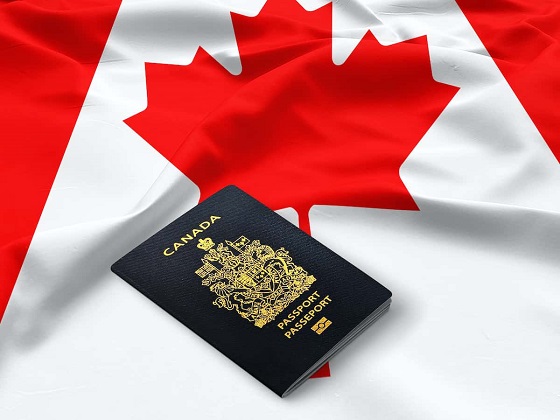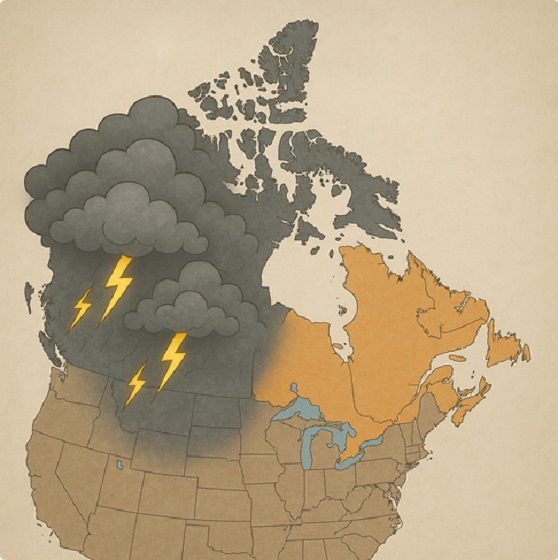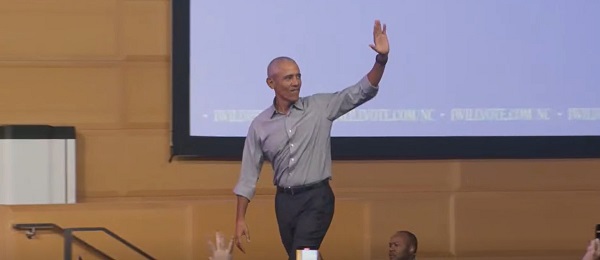Frontier Centre for Public Policy
Carney Risks Repeating Trudeau’s Immigration Failures

From the Frontier Centre for Public Policy
Canada is not and never has been anti-immigrant. Immigration built this country, and it will continue to do so. But immigration policy must serve the national interest, not overwhelm it.
Canadians want Carney to abandon Trudeau’s failed immigration model and set immigration at a pace Canada can sustain
Canada is buckling under the weight of unsustainable immigration levels, and Prime Minister Marc Carney’s early decisions suggest he plans to keep following Justin Trudeau’s failed path.
Carney’s recent plan to bring in thousands of elderly retirees from India raises an obvious question. No disrespect is intended toward India or those retirees, but Canadians are asking how this serves their interests. Our hospitals are overcrowded, our housing market is out of reach for young families, and our social services are under immense strain. Adding more retirees will increase the pressure on already strained systems.
Many had hoped Carney would pivot from Trudeau’s disastrous policies. Instead, he appears set to double down.
Under Trudeau, housing construction lagged badly, with only about 200,000 homes built each year while the population grew by nearly a million. When nearly a million newcomers arrive each year but only 200,000 homes are built, the math simply doesn’t work.
The result was skyrocketing rents, collapsing affordability, and young Canadians watching the dream of home ownership slip away. Health care, education and other public services were swamped. The crisis Carney has inherited is severe; his early moves suggest he may only deepen it.
Conservative Leader Pierre Poilievre has given voice to what most Canadians already believe: the pace of immigration must be slowed. As he put it, “We need to ensure that more leave than come in over the next couple of years, while we catch up, while housing, health care and jobs can catch up.” That is not radical. It is common sense.
Canada is not and never has been anti-immigrant. Immigration built this country, and it will continue to do so. But immigration policy must serve the national interest, not overwhelm it.
For nearly 150 years, Canada followed a clear consensus: newcomers were welcomed in sustainable numbers, chosen for their ability to contribute, and integrated into Canadian life. That model admitted fewer people overall, prioritized skilled workers, and required language ability and proof of economic contribution. It made Canada one of the most successful immigrant societies in the world.
Trudeau shattered that consensus. In 2017, seeking to posture against Donald Trump, he tweeted that Canada welcomed anyone, anywhere, no questions asked.
They came, many through unofficial crossings such as Roxham Road, a small rural road south of Montreal that became the country’s busiest irregular entry point.
The Safe Third Country Agreement requires refugees to claim asylum in the first safe country they enter, but it applied only at official crossings, not irregular ones like Roxham Road. As a result, Canada was required to process all asylum claims made there.
Others arrived as “students” or “temporary workers,” often with limited verification of their claims. Tens of thousands entered outside the regular application process, ahead of applicants waiting abroad who had spent years preparing careful applications.
The costs are now undeniable. Services are collapsing under the strain. Housing affordability is at historic lows. Social cohesion is fraying, with growing frustration spilling onto social media.
Canadians who question policy are often dismissed as “far right,” stifling legitimate debate and ignoring the very real damage being done to their quality of life.
Carney now faces a clear choice. He can continue Trudeau’s reckless course, or he can restore the balanced immigration system that served Canada so well for generations.
He does not need to reinvent the wheel. The pre-2015 model showed that a nation can welcome newcomers generously while protecting its own social fabric. That model worked because it respected limits. A country must control its borders, carefully vet entrants, and admit only as many as it can realistically absorb.
The lesson is simple: numbers matter. Without a return to sustainable immigration levels, Canada’s health care, housing and education systems will continue to buckle, and the trust of Canadians in their leaders will erode further.
The longer we delay, the harder it will be to repair the damage. Young families already priced out of the housing market cannot wait another decade for relief. Hospitals already running at capacity cannot handle more unchecked demand.
Carney talks about being willing to pivot. Immigration is where he must prove it. Canadians are not asking for closed doors. They are asking for control, balance and common sense.
If he delivers, Canada can remain a country that welcomes newcomers while protecting the services and opportunities that make this nation attractive in the first place.
If Carney fails, the Canada we pass to our children won’t be the country we once knew.
Brian Giesbrecht is a retired judge and a senior fellow at the Frontier Centre for Public Policy.
Business
Privatizing Canada Post Is The Only Solution Left

From the Frontier Centre for Public Policy
By Conrad Eder
Endless bailouts won’t fix Canada Post’s broken business model
Canada Post is bleeding taxpayers dry. In 2024 alone, it lost nearly $1.3 billion and saw revenues fall by $800 million—a staggering 12.2 per cent year-over-year decline. These grim figures forced a $1 billion taxpayer bailout in January.
And the crisis is far from over. Beginning in 2026, Canada Post itself projects it will need another $1 billion every year simply to survive.
This is not a temporary slump. It is a structural failure. Since 2018, Canada Post has accumulated losses of more than $3.8 billion. The message is clear: Canadians aren’t getting mail—they’re getting fleeced.
Yet despite overwhelming evidence of collapse, proposals to privatize the service continue to face resistance from those nostalgic for a bygone era. That nostalgia is costly. Every billion-dollar bailout is a billion dollars not spent on hospitals, schools and infrastructure. Imagine what $1 billion a year could mean for health care wait times, long-term care beds, or repairing crumbling bridges. Instead, Canadians are spending it to keep an outdated postal service on life support.
Critics of privatization argue that only a public entity can guarantee affordable, universal service. They warn that private operators would reduce access, raise prices and abandon rural Canada.
But the European experience tells a different story. Germany’s Deutsche Post, privatized in 1995, expanded its services globally while maintaining affordable domestic delivery. The Netherlands’ PostNL streamlined operations and introduced innovative parcel services to meet the demands of online shopping. Austria Post invested heavily in automation and developed flexible delivery options. In all three cases, universal service requirements were preserved, prices remained affordable, and customers benefited from enhanced, innovative services.
By contrast, Canada Post’s outdated monopoly model is a straitjacket. It must deliver to every address, no matter the cost, while being forced to seek government approval for even modest changes. This bureaucracy means political considerations routinely trump business logic. While private competitors can adjust pricing, delivery models and technology overnight, Canada Post waits months—sometimes years—for permission to act.
As if structural flaws weren’t enough, labour instability has become another costly burden. A recent 32-day strike cost Canada Post more than $200 million.
While the Canadian Union of Postal Workers has every right to defend its members, it has consistently resisted reforms like flexible staffing and automated systems. These are precisely the changes needed to bring the service into the modern era. With taxpayer bailouts guaranteeing survival, CUPW faces little pressure to change course. Canada Post has become less of a postal service than a taxpayer-funded job protection scheme.
Former CEO Moya Greene understood this reality. After leaving Canada Post, she led the UK’s Royal Mail through successful privatization. Her experience showed that public postal services can modernize without abandoning universal service. The lesson is simple: performance improves when failure is possible.
Critics warn about the dangers of the profit motive. But Canada Post already raises postage rates while continuing to post massive losses. Canadians are paying more and getting less. Profit, unlike politics, demands accountability. Companies that fail to deliver value lose customers. Crown corporations, shielded by bailouts, lose nothing.
Fixing Canada Post will take more than tinkering. Incremental reforms cannot solve a billion-dollar-a-year problem. Canada must end its monopoly, open the market and privatize the service. A privatized model can be designed to ensure continued universal delivery, just as in Europe, while giving operators the flexibility to innovate and compete.
Privatization is neither reckless nor radical. It is a proven solution to a financial and operational crisis. Canadians deserve more than excuses and nostalgia. They deserve a postal service that delivers goods to Canadians, not one that delivers bills to taxpayers.
Conrad Eder is a policy analyst at the Frontier Centre for Public Policy.
COVID-19
Tamara Lich’s Prosecution Is A Warning To Western Canada

From the Frontier Centre for Public Policy
The Tamara Lich trial shows just how far Ottawa will go to crush dissent, especially in the West
Tamara Lich’s prosecution isn’t just about a protest—it’s a warning. For many Western Canadians, her harsh treatment by Ottawa signals how far the federal government is willing to go to silence dissent. As Alberta moves toward a sovereignty referendum, Lich’s ordeal stands as a troubling omen of how Ottawa may respond to serious challenges to its authority.
Tamara Lich, a key organizer of the 2022 Freedom Convoy protest in Ottawa, became a central figure in a nationwide debate over pandemic mandates and civil liberties. She travelled to Ottawa to protest what she and many Canadians viewed as the federal government’s heavy-handed pandemic measures. Rather than respond with dialogue, the Trudeau government cracked down—hard. Lich was arrested, denied bail and now faces a potential seven-year sentence for her role in the peaceful protest.
That sentence exceeds those handed to violent offenders in some cases. One man, for example, stabbed his girlfriend three times and hit another woman with a pipe—yet received only a short sentence. Lich, meanwhile, faces seven years for mischief and breaching bail conditions. That’s not justice. It’s deterrence by example.
The disparity becomes even more striking when viewed in the broader context of the Freedom Convoy itself. The protest began in early 2022, when thousands of truckers and their supporters drove to Ottawa to oppose federal COVID-19 vaccine mandates, especially for cross-border drivers. The demonstration, which blocked downtown streets for several weeks, drew both support and condemnation across the country.
While the protest was disruptive, it was peaceful. That stands in contrast to the leniency shown toward other protest movements that involved far more dangerous actions. Protesters involved in the Wet’suwet’en rail blockades, Black Lives Matter demonstrations, or recent pro-Hamas marches engaged in activities that included burning rail tracks, toppling statues and threatening public safety—yet many escaped charges entirely or received minimal penalties. In Lich’s case, even honking a horn has been treated like a criminal conspiracy.
So what exactly did Tamara Lich do? She helped organize a peaceful protest. She spoke out against government overreach. She called for a meeting with the prime minister. That’s it.
The trucker-led convoy that she helped inspire emerged in response to a final, baffling mandate: that cross-border truckers be vaccinated against COVID-19. This came long after it was clear the vaccines didn’t prevent transmission. The mandate was political, not scientific. The truckers knew it. Ottawa knew it. Yet instead of backing down, the Trudeau government doubled down.
And this wasn’t an isolated example of government excess. Throughout the pandemic, Ottawa pushed increasingly arbitrary and often absurd restrictions. Playgrounds were closed. People were told to stay indoors and avoid outdoor air. Provincial premiers were pressured into compliance by threats to federal funding. Rules shifted weekly, often with little logic or explanation.
When Canadians finally pushed back, they weren’t met with humility or dialogue. They were met with insults. Trudeau had earlier described unvaccinated Canadians as “often misogynists, also often racists,” questioning whether society should “tolerate these people”—remarks widely seen as contributing to the hostile tone later directed at convoy protesters.
He refused to meet with them. He retreated to his cottage and then reached for the Emergencies Act—the first time it had ever been used in Canadian history, raising serious civil liberties concerns across the political spectrum.
It froze bank accounts, targeted private citizens and brought down the full weight of the state on people who were engaged in peaceful civil disobedience.
The legacy media echoed the government line, portraying protesters as dangerous extremists. The Ottawa police became aggressive. Even the chief justice of the Supreme Court made comments that blurred the line between judicial neutrality and political messaging. The signal was unmistakable: dissent would not be tolerated.
Why such an overreaction? Because the protest threatened not public safety, but political control. It exposed the disconnect between ordinary Canadians and the Ottawa elite, and it risked uniting voters across regional and political lines.
So the federal government chose to make an example of Lich. In doing so, they sent a chilling message: resist us, and we will ruin you.
That message matters now more than ever. Alberta is preparing for a sovereignty referendum—a vote designed to test whether the province should assert more control over taxation, natural resources and other federal matters. If Lich’s treatment is any indication, Ottawa will not respond kindly.
Expect the full machinery of the federal government, legal, financial and rhetorical, to be deployed to crush dissent, divide communities and discredit the movement.
There’s an old expression: punish a few to scare the many.
That’s what has happened here. Lich’s ordeal is not about justice. It’s about power. It’s about control. And it’s about sending a warning to anyone who dares question the authority of the federal government.
Lich will be remembered as a heroine in the West and a troublemaker in the East—a divide that says more about Canada than it does about her.
Her treatment is not the mark of a healthy democracy. It’s the sign of a government that no longer tolerates dissent. And it’s a very bad omen for Western Canadians who still believe in the right to speak out, stand up and say no.
Brian Giesbrecht is a retired judge and a senior fellow at the Frontier Centre for Public Policy.
-

 International1 day ago
International1 day agoDOJ orders grand jury investigation into Russiagate
-

 Alberta10 hours ago
Alberta10 hours agoAlberta health system accused of pressuring women to abort babies with Down syndrome
-

 Business1 day ago
Business1 day agoCanada’s housing density dilemma
-

 Economy24 hours ago
Economy24 hours agoCanada’s Lost Energy Decade!
-

 Daily Caller10 hours ago
Daily Caller10 hours agoBig Tech Cover-Up: Google distorts search results to protect Obama
-

 Business1 day ago
Business1 day agoCarney can rescue health care by loosening restrictions of the Canada Health Act
-

 Business1 day ago
Business1 day agoCarney’s Move to Strip Religious Charities Undermines Canada’s Foundations, Liberal Elder Warns
-

 Bruce Dowbiggin2 days ago
Bruce Dowbiggin2 days agoUnder Pressure: Boo Jays Become Blue Jays. Now What?





